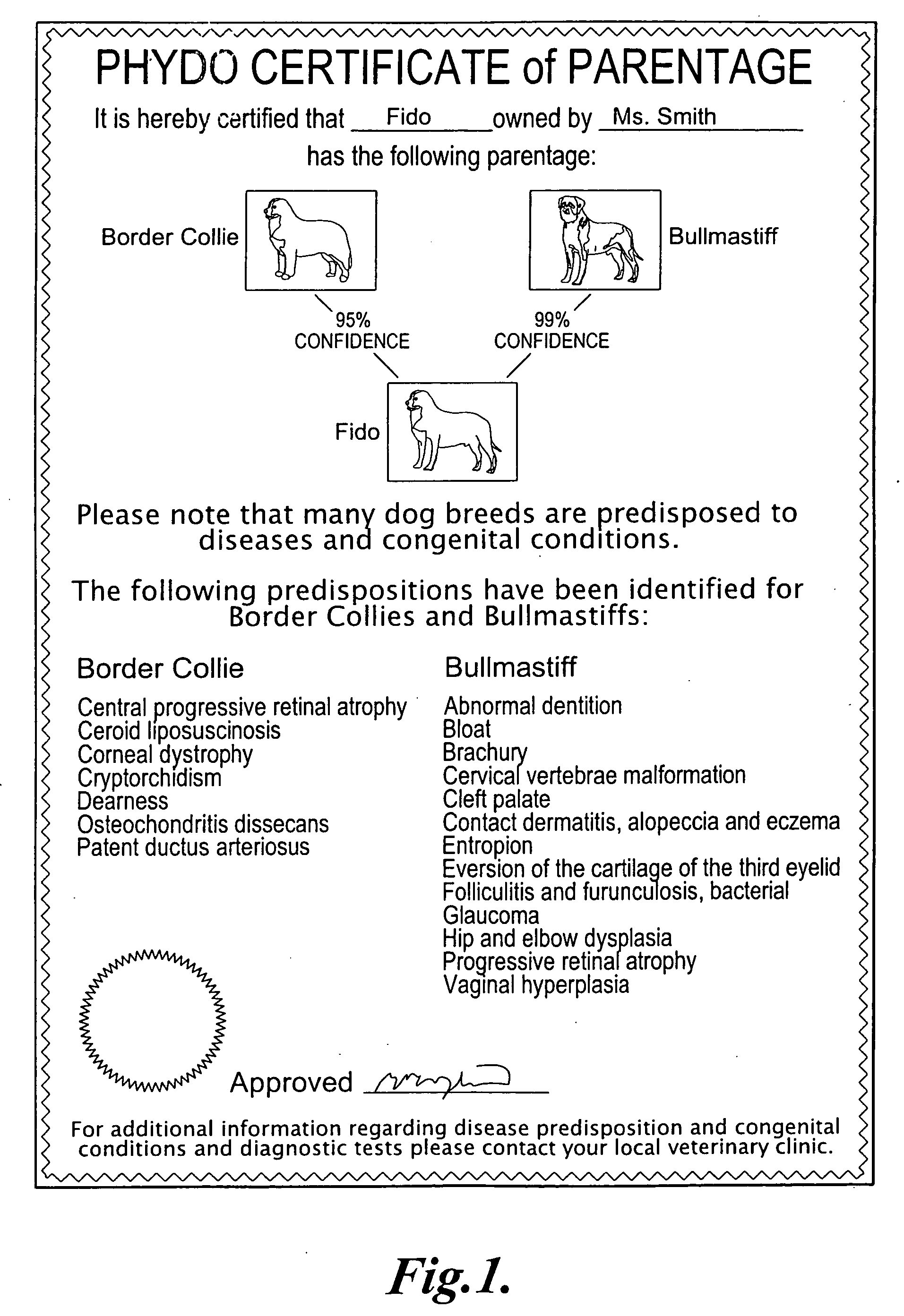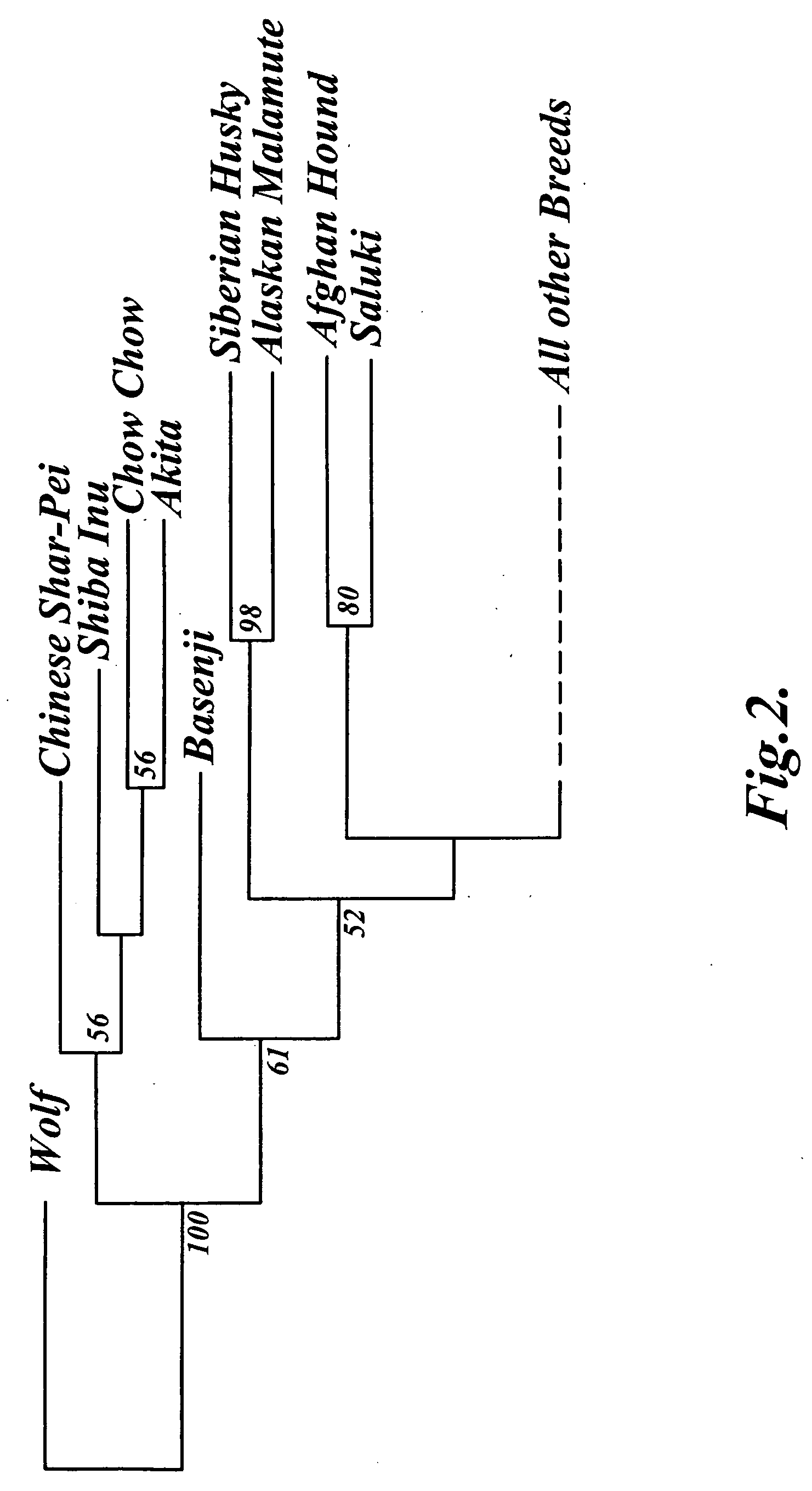Methods and materials for canine breed identification
a technology of canine breeds and methods, applied in the field of methods and materials for canine breed identification, can solve the problems of phylogenetic distance measures and tree building programs not being equipped to deal with reticulate evolution, and the evolution of mitochondrial dna is too slow to allow inference of relationships among modern dog breeds
- Summary
- Abstract
- Description
- Claims
- Application Information
AI Technical Summary
Benefits of technology
Problems solved by technology
Method used
Image
Examples
example 1
[0058] This example describes a representative method of the invention for obtaining the identity of one or both alleles for a set of markers and selecting markers suitable for determining the contribution of canid populations to the genome of a canid.
A. Methods
[0059] 1. Sample Collection and DNA Extraction
[0060] Canid DNA samples from 513 American Kennel Club-registered dogs representing 103 breeds and 8 gray wolves from eight countries (China, Oman, Italy, Iran, U.S.A. (Alaska), Canada (Quebec), Sweden, Mexico) were obtained by collecting buccal (cheek) swabs and / or blood samples from volunteers at dog shows and dog club specialty events, as well as by mail-in donations. American Kennel Club registration number and detailed pedigree information was requested for all dogs, as participation was limited to unrelated dogs that did not share grandparents. Pedigree information was also collected for 84% of sampled individuals. In many cases, five-generation pedigrees were obtained, ...
example 2
[0079] This example describes a representative method of the invention for estimating the contributions of canid populations to a canid genome using an assignment test calculator on genotype information for 95 microsatellite markers from 94 canids, and on genotype information for 68 microsatellite markers from 341 canids.
A. Methods
[0080] 1. Datasets
[0081] Dataset 1 included genotype information for 95 microsatellite markers from 94 canids, including 90 dogs representing 18 breeds, and 4 wolves (AHRT, AKIT, BEAG, BMD, BOX, BULD, BULM, CHIH, DACH, GOLD, IBIZ, MAST, NEWF, PEKE, POM, PRES, PUG, ROTT, WOLF, see Table 5 for abbreviations of canid populations). The 95 microsatellite markers were microsatellite markers 1-14, 16, 18-21, 23-36, 39-100 (Table 1). The dataset contained genotype information from 5 canids for each breed and 4 wolves (Table 6). The genotype information for the canids in dataset 1 is set forth in Table 3 (filed herewith on a compact disc).
[0082] Dataset 2 incl...
example 3
[0093] This example describes a representative method of the invention for estimating the contributions of canid populations to a canid genome using cluster analysis on genotype information for 95 microsatellite markers from 94 canids.
A. Methods
[0094] 1. Dataset
[0095] Dataset 1 included genotype information for 95 microsatellite markers from 94 canids, including 90 dogs representing 18 breeds, and 4 wolves, as described in EXAMPLE 2.
[0096] 2. Cluster Analysis
[0097] Cluster analysis was performed using the multilocus genotype clustering program structure (Pritchard et al. (2000) Genetics 155:945-59; Falush et al. (2003) Science 299:1582-5), which employs a Bayesian model-based clustering algorithm to identify genetically distinct subpopulations based on patterns of allele frequencies. Multiple runs were completed for each value of K (number of genetic clusters) with burn-in lengths of 10,000 steps and 100,000 iterations of the Gibbs sampler. The correlated allele frequency mode...
PUM
 Login to View More
Login to View More Abstract
Description
Claims
Application Information
 Login to View More
Login to View More - R&D
- Intellectual Property
- Life Sciences
- Materials
- Tech Scout
- Unparalleled Data Quality
- Higher Quality Content
- 60% Fewer Hallucinations
Browse by: Latest US Patents, China's latest patents, Technical Efficacy Thesaurus, Application Domain, Technology Topic, Popular Technical Reports.
© 2025 PatSnap. All rights reserved.Legal|Privacy policy|Modern Slavery Act Transparency Statement|Sitemap|About US| Contact US: help@patsnap.com



